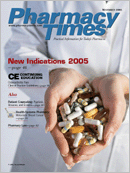Publication
Article
Pharmacy Times
A Pharmacist's Guide to OTC Therapy: Cough and Cold Products
Author(s):
Approximately 62 million cases of the common cold occur annually in the United States. Preschool-age children usually have 5 to 7 colds per year, whereas adults typically may have 2 to 3 colds annually.1 The common cold does not have a cure. With the variety of nonprescription products available, however, many individuals frequently attempt to self-medicate in order to alleviate the symptoms associated with the common cold. In most cases, therapy with nonprescription cold products relieves symptoms, but pharmacists should recommend that patients seek medical care if their symptoms persist or if they have the symptoms mentioned in Table 1.
A plethora of nonprescription agents are available either as single-entity products or as combination products in various formulations to address the specific needs of various patient populations, including the pediatric population and the diabetic patient population (Tables 2-4). Children <1 year of age should not be given any nonprescription cold medications except under the direction of a primary care provider.1
Prior to recommending any OTC products to a patient, pharmacists should assess an individual's current medication profile, allergy history, and medical history to determine whether possible contraindications exist. It also is important to recommend nonpharmacologic measures, such as adequate hydration and proper rest. Patients always should be referred to their primary health care provider, if warranted.
Pharmacists can aid patients in proper product selection based upon symptoms, medical history, lifestyle, and dosage preferences and can guide patients with coexisting medical conditions to seek medical care from their primary health care provider. Patients should always be aware of the potential adverse effects, such as drowsiness, when taking these medications.
Pharmacists should counsel patients with regard to proper dosing guidelines for the pediatric patient population, and pharmacists should evaluate the possibility of therapeutic duplications if patients are taking multisymptom cold preparations.
In summary, although no cure exists for the common cold, pharmacists can aid patients in making appropriate choices for treating the common cold and also preventing further complications.
Ms. Terrie is a clinical pharmacy writer based in the northern Virginia area.
For a list of references, send a stamped, self-addressed envelope to: References Department, Attn. A. Stahl, Pharmacy Times, 241 Forsgate Drive, Jamesburg, NJ 08831; or send an e-mail request to: [email protected].







